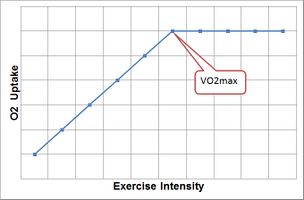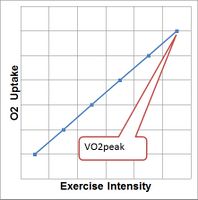Difference between revisions of "VO2max"
User:Fellrnr (User talk:Fellrnr | contribs) |
User:Fellrnr (User talk:Fellrnr | contribs) |
||
| (4 intermediate revisions by the same user not shown) | |||
| Line 1: | Line 1: | ||
[[File:VO2max.jpg|right|thumb|x200px|A graph showing that O<sub>2</sub> consumption increases with exercise intensity until a maximum is reached, which is V̇O<sub>2</sub>max.]] | [[File:VO2max.jpg|right|thumb|x200px|A graph showing that O<sub>2</sub> consumption increases with exercise intensity until a maximum is reached, which is V̇O<sub>2</sub>max.]] | ||
| − | V̇O<sub>2</sub>max is the maximum (max) volume (V) of oxygen (O<sub>2</sub>) you can use during exercise. Measuring V̇O<sub>2</sub>max requires specialist equipment, but there are many locations with the facilities and the cost is usually under $100. The procedure involves running on a treadmill while wearing a mask to capture your breath. There is a warm up period, and then you run at a reasonably stressful pace while the treadmill gradient is steadily increased until you can't keep going. For most of the test, as the workload increases so does the O<sub>2</sub> you use. However, there will come a point where the increased workload does not have a corresponding increase in O<sub>2</sub> usage. This is the point where you are using as much O<sub>2</sub> as you are capable of and | + | V̇O<sub>2</sub>max is the maximum (max) volume (V) of oxygen (O<sub>2</sub>) you can use during exercise. Measuring V̇O<sub>2</sub>max requires specialist equipment, but there are many locations with the facilities and the cost is usually under $100. The procedure involves running on a treadmill while wearing a mask to capture your breath. There is a warm up period, and then you run at a reasonably stressful pace while the treadmill gradient is steadily increased until you can't keep going. For most of the test, as the workload increases so does the O<sub>2</sub> you use. However, there will come a point where the increased workload does not have a corresponding increase in O<sub>2</sub> usage. This is the point where you are using as much O<sub>2</sub> as you are capable of and the increased workload is coming from anaerobic systems. While V̇O<sub>2</sub>max is interesting, it does not include details of [[Running Economy]], so it does not give a complete picture of a runner's capabilities. Arguably, [[VDOT]] is a more useful measure of fitness. |
| − | + | =Estimating VO2max= | |
| − | + | V̇O<sub>2</sub>max can be estimated from a race performance, and this is implemented in the [[VDOT Calculator]]. Another approach is the Cooper test developed in 1968 found that the distance that could be covered in 12 minutes was strongly correlated with VO2max<ref name="Cooper1968"/>. However, the Cooper test requires a lot of [[Motivation|motivation]] and a good sense of pacing, as 12 minutes is a relatively long period for this type of test<ref name="Billat-1996"/>. A similar technique is to increase running speed every two minutes until exhaustion, then VO2max can be estimated from the maximum speed that was achieved using Léger & Mercier formula:<ref name="Léger-1984"/>: | |
| − | + | V̇O<sub>2</sub>max = speed * 3.5 | |
| − | |||
| − | |||
| − | |||
Where V̇O<sub>2</sub>max is in ml/Kg/min and vV̇O<sub>2</sub>max is in km/hr. | Where V̇O<sub>2</sub>max is in ml/Kg/min and vV̇O<sub>2</sub>max is in km/hr. | ||
| − | |||
=V̇O<sub>2</sub>max and V̇O<sub>2</sub>peak= | =V̇O<sub>2</sub>max and V̇O<sub>2</sub>peak= | ||
[[File:VO2peak.jpg|right|thumb|x200px|This graph shows that V̇O<sub>2</sub>peak, which is the highest O<sub>2</sub> observed, without the plateau that defines V̇O<sub>2</sub>max.]] | [[File:VO2peak.jpg|right|thumb|x200px|This graph shows that V̇O<sub>2</sub>peak, which is the highest O<sub>2</sub> observed, without the plateau that defines V̇O<sub>2</sub>max.]] | ||
| − | Some research uses the term V̇O<sub>2</sub>peak rather than V̇O<sub>2</sub>max, and while the two are similar, there is an important difference. Where V̇O<sub>2</sub>max is the highest O<sub>2</sub> uptake seen, even though exercise intensity has continued to increase, V̇O<sub>2</sub>peak is simply the highest O<sub>2</sub> seen<ref name="Whipp"/>. | + | Some research uses the term V̇O<sub>2</sub>peak rather than V̇O<sub>2</sub>max, and while the two are similar, there is an important difference. Where V̇O<sub>2</sub>max is the highest O<sub>2</sub> uptake seen, even though exercise intensity has continued to increase, V̇O<sub>2</sub>peak is simply the highest O<sub>2</sub> seen<ref name="Whipp"/>. It's possible for V̇O<sub>2</sub>peak to be the same as V̇O<sub>2</sub>max, but only if the test is terminated at just the right point. The biggest problem with V̇O<sub>2</sub>peak is that a training program might result in a subject getting better at the test, which would result in a higher V̇O<sub>2</sub>peak value, without actually changing their V̇O<sub>2</sub>max. For instance, I might have a V̇O<sub>2</sub>max of 60, but find the testing protocol so hard that I give up when my V̇O<sub>2</sub> reaches 50 which would only give a V̇O<sub>2</sub>peak value. If I do some high intensity training, I'd be more comfortable at these high workloads and I might reach a V̇O<sub>2</sub>peak of 55, which would look like a 10% improvement, but is actually not a change in physical fitness. |
| + | =V̇O<sub>2</sub>max and vV̇O<sub>2</sub>max= | ||
| + | The velocity that is reached at V̇O<sub>2</sub>max is called [[vVO2max| vV̇O<sub>2</sub>max]], and the time that [[vVO2max| vV̇O<sub>2</sub>max]] can be sustained for is called T<sub>lim</sub> or T<sub>max</sub>. | ||
=References= | =References= | ||
<references> | <references> | ||
| − | |||
<ref name="Whipp">THE PEAK VERSUS MAXIMUM OXYGEN UPTAKE ISSUE, Brian J. Whipp, Ph.D., D.Sc., Institute of Membrane and Systems Biology, University of Leeds,Leeds, UK</ref> | <ref name="Whipp">THE PEAK VERSUS MAXIMUM OXYGEN UPTAKE ISSUE, Brian J. Whipp, Ph.D., D.Sc., Institute of Membrane and Systems Biology, University of Leeds,Leeds, UK</ref> | ||
| + | <ref name="Cooper1968">Kenneth H. Cooper, A Means of Assessing Maximal Oxygen Intake<subtitle>Correlation Between Field and Treadmill Testing</subtitle>, JAMA: The Journal of the American Medical Association, volume 203, issue 3, 1968, pages 201, ISSN [http://www.worldcat.org/issn/0098-7484 0098-7484], doi [http://dx.doi.org/10.1001/jama.1968.03140030033008 10.1001/jama.1968.03140030033008]</ref> | ||
| + | <ref name="Billat-1996"> LV. Billat, JP. Koralsztein, Significance of the velocity at VO2max and time to exhaustion at this velocity., Sports Med, volume 22, issue 2, pages 90-108, Aug 1996, PMID [http://www.ncbi.nlm.nih.gov/pubmed/8857705 8857705]</ref> | ||
| + | <ref name="Léger-1984">L. Léger, D. Mercier, Gross energy cost of horizontal treadmill and track running., Sports Med, volume 1, issue 4, pages 270-7, PMID [http://www.ncbi.nlm.nih.gov/pubmed/6390604 6390604]</ref> | ||
</references> | </references> | ||
Latest revision as of 06:04, 16 April 2013
V̇O2max is the maximum (max) volume (V) of oxygen (O2) you can use during exercise. Measuring V̇O2max requires specialist equipment, but there are many locations with the facilities and the cost is usually under $100. The procedure involves running on a treadmill while wearing a mask to capture your breath. There is a warm up period, and then you run at a reasonably stressful pace while the treadmill gradient is steadily increased until you can't keep going. For most of the test, as the workload increases so does the O2 you use. However, there will come a point where the increased workload does not have a corresponding increase in O2 usage. This is the point where you are using as much O2 as you are capable of and the increased workload is coming from anaerobic systems. While V̇O2max is interesting, it does not include details of Running Economy, so it does not give a complete picture of a runner's capabilities. Arguably, VDOT is a more useful measure of fitness.
Contents
1 Estimating VO2max
V̇O2max can be estimated from a race performance, and this is implemented in the VDOT Calculator. Another approach is the Cooper test developed in 1968 found that the distance that could be covered in 12 minutes was strongly correlated with VO2max[1]. However, the Cooper test requires a lot of motivation and a good sense of pacing, as 12 minutes is a relatively long period for this type of test[2]. A similar technique is to increase running speed every two minutes until exhaustion, then VO2max can be estimated from the maximum speed that was achieved using Léger & Mercier formula:[3]:
V̇O2max = speed * 3.5
Where V̇O2max is in ml/Kg/min and vV̇O2max is in km/hr.
2 V̇O2max and V̇O2peak
Some research uses the term V̇O2peak rather than V̇O2max, and while the two are similar, there is an important difference. Where V̇O2max is the highest O2 uptake seen, even though exercise intensity has continued to increase, V̇O2peak is simply the highest O2 seen[4]. It's possible for V̇O2peak to be the same as V̇O2max, but only if the test is terminated at just the right point. The biggest problem with V̇O2peak is that a training program might result in a subject getting better at the test, which would result in a higher V̇O2peak value, without actually changing their V̇O2max. For instance, I might have a V̇O2max of 60, but find the testing protocol so hard that I give up when my V̇O2 reaches 50 which would only give a V̇O2peak value. If I do some high intensity training, I'd be more comfortable at these high workloads and I might reach a V̇O2peak of 55, which would look like a 10% improvement, but is actually not a change in physical fitness.
3 V̇O2max and vV̇O2max
The velocity that is reached at V̇O2max is called vV̇O2max, and the time that vV̇O2max can be sustained for is called Tlim or Tmax.
4 References
- ↑ Kenneth H. Cooper, A Means of Assessing Maximal Oxygen Intake<subtitle>Correlation Between Field and Treadmill Testing</subtitle>, JAMA: The Journal of the American Medical Association, volume 203, issue 3, 1968, pages 201, ISSN 0098-7484, doi 10.1001/jama.1968.03140030033008
- ↑ LV. Billat, JP. Koralsztein, Significance of the velocity at VO2max and time to exhaustion at this velocity., Sports Med, volume 22, issue 2, pages 90-108, Aug 1996, PMID 8857705
- ↑ L. Léger, D. Mercier, Gross energy cost of horizontal treadmill and track running., Sports Med, volume 1, issue 4, pages 270-7, PMID 6390604
- ↑ THE PEAK VERSUS MAXIMUM OXYGEN UPTAKE ISSUE, Brian J. Whipp, Ph.D., D.Sc., Institute of Membrane and Systems Biology, University of Leeds,Leeds, UK

